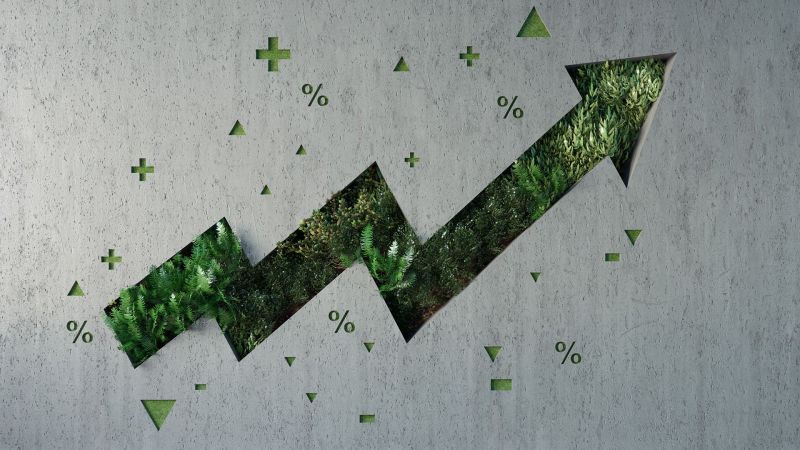The Cost of Uncertainty
Economic policy uncertainty arising from recessions, pandemics, confusing tax policies and, yes, scary election results has real-world consequences

Some of us may be reeling from the results of the recent U.S. election but at least something productive has come out of it: The hidden hand of uncertainty is now out in the open.
Abstractly, we understand how confounding events — recessions, pitched political battles — can mess with our ability to move forward as a society. When a global shock occurs, such as a seismic political event or global pandemic, the power of uncertainty is visceral. Forces long taken for granted suddenly become hot topics around the kitchen table. We are now a lot more aware of the fragility of the global supply chain thanks to Covid.
Macroeconomic uncertainty may be a growing public concern. But researchers worldwide have been studying it for the last decade. Largely out of the public eye, they have identified and measured the far-reaching effects of what is referred to as economic policy uncertainty (EPU). EPU reflects how a national economy fluctuates due to unpredictable fiscal, political, regulatory or monetary policies.
That pretty much describes our roller-coaster existence: the financial crisis of 2008, Brexit, bank failures, the lack of consensus on climate change policies, contested election outcomes, a war in Europe. Not to mention long established economic patterns that are shifting in unpredictable ways.
Measuring uncertainty
EPU-related research has soared since 2016, when a team of U.S. academics developed the Economic Policy Uncertainty Index. The index, which is now updated daily, is constructed from newspaper coverage, provisions in federal tax codes that are set to expire and disagreement among economic forecasters. The index has spiked in all the places you would expect: tight elections, wars, sovereign debt crises and other times of national or global mayhem.
Since then, other uncertainty indices have developed based on Twitter posts, earnings conference-call transcripts, outbreaks of infectious disease, global trade developments — you name it. We have uncertainty covered from all angles.
Thanks to these indices and the research they inspired, we know quite a bit about the economic effects of policy uncertainty. We know, for example, that in times of high uncertainty, firms struggle to plan. They act more conservatively, hoard cash, delay hiring and freeze investments in big projects.
High EPU increases risk across-the-board. Lending costs rise. Plans for initial public offerings are shelved. Venture capital investors back fewer entrepreneurs. Though uncertain conditions could create opportunities for startups, it’s no picnic for would-be founders. Studies show that, under high EPU, startups are less likely to have a successful exit via merger or acquisition and the number of patenting inventors decreases.
This all has a significant — and insidious — impact on national economies. The developers of the EPU Index, for example, estimated that the rise in policy uncertainty between 2006 and 2011 reduced real GDP in the U.S. by 3.2 per cent and cost 2.3 million jobs. (While economic policy uncertainty and weaker economic growth are related, the first does not necessarily cause the second.)
“I definitely think that governments should be aware of policy uncertainty and the impact it has on the decisions of management and investors,” says Lynnette Purda, a professor and RBC Fellow of Finance at Smith School of Business.
Market analysts befuddled
Purda’s research shows how economic policy uncertainty imposes its will on a significant section of the investment community: market analysts. For her study, Purda teamed up with Lamia Chourou and Samir Saadi, both of Telfer School of Management and alumni of the Smith School of Business PhD program.
The researchers examined the earnings reports of security analysts over 30 periods to see how they were influenced by EPU. They figured that when analysts were uncertain about which economic policies would be adopted and what impact they would have, their forecasts would be less accurate.
The study confirmed their hunch: forecast errors increased under high EPU, as did the range of possible predictions across all analysts covering a given firm. Forecast error and dispersion increased with policy uncertainty across a broad range of firms and levels of analyst expertise. This is a disquieting finding for investors relying on the recommendations of security analysts.
“One of the most surprising things for us was just how broad the impact of EPU really was,” says Purda. “We looked at industries we had identified as policy sensitive and expected that most of our findings would be concentrated in that group of companies. But it wasn’t. It was really across the entire spectrum.”
They also showed that economic policy uncertainty is a unique type of ambiguity. In their study, Purda and her colleagues controlled for elections, recessions and other sources of economy-wide uncertainty, and the effect of EPU on analyst forecast error was independent of these other sources. When they looked at the EPU values in election years versus non-election years, there was no statistically different value. As other studies have found, an election outcome is just one dimension of EPU.
Clarity where possible
Uncertainty is a design feature of human existence and economic systems. Certitude is illusory. Given that, what can politicians, policy-makers and regulators do to mitigate the ill effects of economic policy uncertainty?
For one, they need to understand the cost of uncertainty. They may think they are politically savvy by punting hot-button issues to the future or offering transitory stopgaps just to get past a bad news cycle. But there are real costs to the national economy.

If they were sufficiently alarmed by high EPU, they would commit to transparency and predictability where possible. Researchers in this field point to the importance of clarity in policy design, statements, objectives and timelines. Ideally, regulatory and tax systems would be simple to understand and easy to administer. When times are unavoidably bumpy and investment dries up, governments would step in and support the entrepreneurial sector with bridge financing.
Canada offers an example of how to work around uncertain conditions. At present, firms investing in clean energy can earn tradeable carbon credits based on the level of emissions they reduce. But too many are reluctant to make such investments because of the uncertainty of the carbon pricing regime and long-term political commitment.
Recognizing this, the federal government announced in its recent budget that it would offer “contracts for difference”, essentially committing the Canada Infrastructure Bank or a similar government entity to provide a backstop should the market price of tradeable carbon credits fall below the minimum price in the contract.
Managing EPU
But it is not only policy-makers that need to manage for uncertainty. Organizations could certainly do a better job of considering EPU in their risk profiles and hedging against associated risks. Firms with policy exposure, for example, could strengthen their connections with legislators and regulators. Some have argued that paying higher dividends could help alleviate the risks associated with uncertainty.
Investors can wise up on policy uncertainty as well. At present, investors do not appear to take any action to avoid macroeconomic risk. Researchers have found that investors are willing to pay hefty prices to hedge against future risks but not to avoid or hedge against uncertainty, even though doing so is less costly. Perhaps this should change.
While we’re blue-skying, how about publicizing the national and global measures of the EPU Index every quarter, alongside economic indicators such as GDP, the consumer price index and the unemployment rate? EPU provides an important picture of the macroeconomic environment. Some have suggested that uncertainty shocks have more predictive power than monetary policy in forecasting unemployment rates. Regularly publicizing EPU measures would also remind policy-makers to consider their role in creating an uncertain environment in the first place.
And, if all else fails, Bitcoin has been shown to be a hedge against economic policy uncertainty. So, if you have a taste for cryptocurrency and all around you is in disarray, there’s always that.
This article was originally published on May 5, 2023 and was updated on November 7, 2024.





